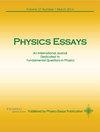A Euclidean geometric model that has a maximum speed c
IF 0.5
Q4 PHYSICS, MULTIDISCIPLINARY
引用次数: 1
Abstract
Introduce a standard Euclidean geometric model with a maximum speed c, which may help us understand why the speed of light c is the universe's maximum speed, why parameter c is a constant, and the geometric mechanism that causes time dilation and length contraction. Finally, based on this model, this paper will present a new coordinate transformation and general velocity addition formula. The new general velocity addition formula is not only consistent with the Michelson‐Morley experiment but also consistent with the one-way speed of light experiment and the linear Sagnac experiment.具有最大速度c的欧几里得几何模型
引入一个最大速度为c的标准欧几里得几何模型,可以帮助我们理解为什么光速c是宇宙的最大速度,为什么参数c是常数,以及导致时间膨胀和长度收缩的几何机制。最后,在此模型的基础上,给出了一种新的坐标变换和一般速度相加公式。新的广义速度相加公式不仅与michael - Morley实验一致,而且与单向光速实验和线性Sagnac实验一致。
本文章由计算机程序翻译,如有差异,请以英文原文为准。
求助全文
约1分钟内获得全文
求助全文
来源期刊

Physics Essays
PHYSICS, MULTIDISCIPLINARY-
自引率
83.30%
发文量
50
审稿时长
6-12 weeks
期刊介绍:
Physics Essays has been established as an international journal dedicated to theoretical and experimental aspects of fundamental problems in Physics and, generally, to the advancement of basic knowledge of Physics. The Journal’s mandate is to publish rigorous and methodological examinations of past, current, and advanced concepts, methods and results in physics research. Physics Essays dedicates itself to the publication of stimulating exploratory, and original papers in a variety of physics disciplines, such as spectroscopy, quantum mechanics, particle physics, electromagnetic theory, astrophysics, space physics, mathematical methods in physics, plasma physics, philosophical aspects of physics, chemical physics, and relativity.
 求助内容:
求助内容: 应助结果提醒方式:
应助结果提醒方式:


